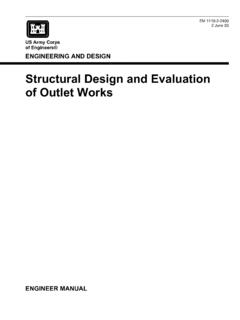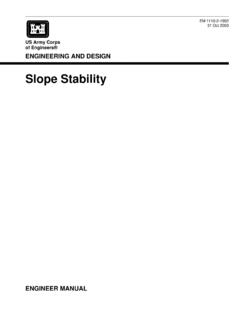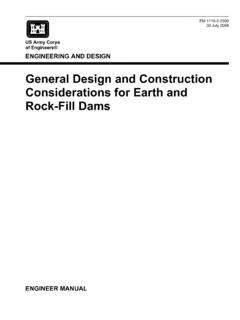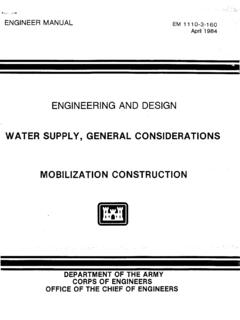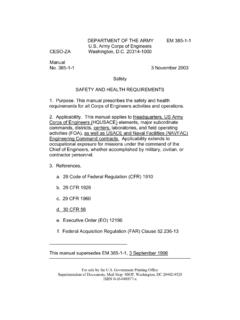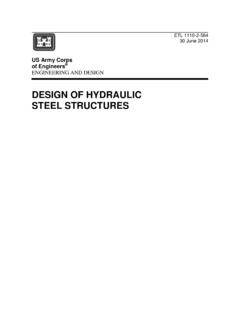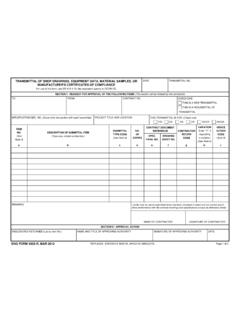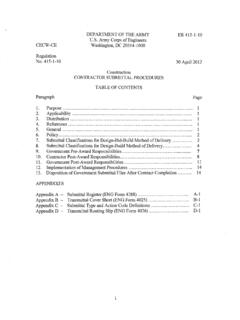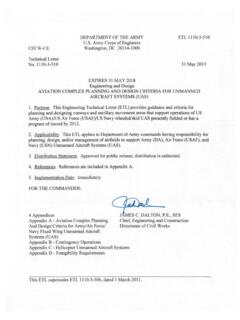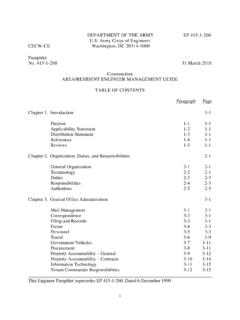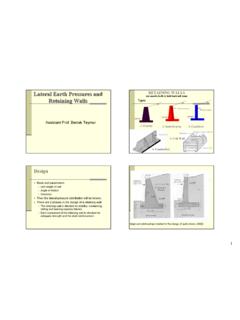Transcription of STABILITY ANALYSIS OF CONCRETE STRUCTURES
1 EM 1110-2-2100 1 December 2005 US Army Corps of Engineers ENGINEERING AND DESIGN STABILITY ANALYSIS OF CONCRETE STRUCTURES ENGINEER MANUAL No. 1110-2-2100 EM 1110-2-2100 1 Dec 05 i DEPARTMENT OF THE ARMY Army Corps of Engineers Washington, 20314-1000 Engineering and Design STABILITY ANALYSIS OF CONCRETE STRUCTURES Table of Contents Subject Paragraph Page Chapter 1 General Purpose.
2 1-1 1-1 Applicability .. 1-2 1-1 References .. 1-3 1-1 Distribution Statement .. 1-4 1-1 Mandatory 1-5 1-1 1-6 1-1 1-7 1-2 Coordination .. 1-8 1-3 Chapter 2 Failure Modes and Wedge Sliding ANALYSIS General .. 2-1 2-1 Limit Equilibrium ANALYSIS .. 2-2 2-1 Sliding Planes .. 2-3 2-1 Resultant Location.
3 2-4 2-2 Flotation .. 2-5 2-2 Bearing .. 2-6 2-2 Geotechnical Explorations and Testing .. 2-7 2-3 Shear Strength Tests .. 2-8 2-3 Selection of Design Shear Strengths .. 2-9 2-5 Multiple Wedge Sliding ANALYSIS .. 2-10 2-6 Single Wedge Sliding ANALYSIS .. 2-11 2-8 Mandatory 2-12 2-8 Chapter 3 STABILITY Requirements General .. 3-1 3-1 Load Condition Categories .. 3-2 3-1 Risk-based ANALYSIS for USACE Flood Project 3-3 3-2 Site 3-4 3-3 Critical STRUCTURES .
4 3-5 3-3 Existing STRUCTURES .. 3-6 3-4 Factors of Safety for 3-7 3-4 Factors of Safety for 3-8 3-5 Limits on Resultant 3-9 3-5 Allowable Bearing Capacity .. 3-10 3-6 EM 1110-2-2100 1 Dec 05 ii Seismic 3-11 3-6 Mandatory 3-12 3-7 Chapter 4 Loads and Loading Conditions General .. 4-1 4-1 4-2 4-1 Water Loading Conditions .. 4-3 4-1 Uplift Loads .. 4-4 4-2 Maintenance Conditions .. 4-5 4-3 Surge and Wave Loads .. 4-6 4-3 Earthquake Loading 4-7 4-4 Other Loads.
5 4-8 4-6 Mandatory 4-9 4-7 Chapter 5 Soil Forces and Single Wedge Sliding ANALYSIS General .. 5-1 5-1 Single Wedge STABILITY ANALYSIS .. 5-2 5-1 Soil Pressures and 5-3 5-2 Soil Pressures with Water Table Within or Above Top of Backfill Wedge .. 5-4 5-6 Earthquake Inertial Forces on STRUCTURES .. 5-5 5-7 Mandatory 5-6 5-8 Chapter 6 STABILITY Considerations and Analytical Methods General .. 6-1 6-1 Traditional Methods.
6 6-2 6-1 Advanced Analytical 6-3 6-2 Computer Programs .. 6-4 6-4 Mandatory 6-5 6-4 Chapter 7 Evaluating and Improving STABILITY of Existing STRUCTURES General .. 7-1 7-1 Procedures .. 7-2 7-1 Improving STABILITY .. 7-3 7-2 Case Histories .. 7-4 7-3 Mandatory 7-5 7-4 Chapter 8 Anchoring STRUCTURES General .. 8-1 8-1 Anchoring STRUCTURES to Rock .. 8-2 8-1 Tensioned Anchor Loads.
7 8-3 8-2 Structural Anchor Design .. 8-4 8-3 Stressing, Load Testing and Acceptance .. 8-5 8-5 Monitoring Structural Anchor 8-6 8-5 Mandatory 8-7 8-5 EM 1110-2-2100 1 Dec 05 iii Appendix A References Appendix B Loading Conditions and Loading-Condition Classification Appendix C Uplift Appendix D Example Problems Appendix E Wedge Equations Appendix F Effect of Vertical Shear on the STABILITY of Gravity Walls Appendix G Earthquake Forces from Backfill Appendix H Classification of STRUCTURES EM
8 1110-2-2100 1 Dec 05 Chapter 1 General 1-1. Purpose This manual establishes and standardizes STABILITY criteria for use in the design and evaluation of the many various types of CONCRETE STRUCTURES common to Corps of Engineers civil works projects. As used in this manual, the term STABILITY applies to external global STABILITY (sliding, rotation, flotation and bearing), not to internal STABILITY failures such as sliding on lift surfaces or exceedance of allowable material strengths. 1-2. Applicability This manual applies to all USACE commands having responsibilities for civil works projects.
9 1-3. References Required and related publications are listed in Appendix A. 1-4. Distribution Statement Approved for public release, distribution is unlimited. 1-5. Mandatory Requirements Designers performing STABILITY analyses of CONCRETE STRUCTURES are required to satisfy specific mandatory requirements. The purpose of mandatory requirements is to assure the structure meets minimum safety and performance objectives. Mandatory requirements usually pertain to critical elements of the safety ANALYSIS such as loads, load combinations and factors of safety.
10 Mandatory requirements pertaining to the guidance contained in a particular chapter are summarized at the end of that chapter. No mandatory requirements are identified in the appendices. Instead, any mandatory requirements pertaining to information contained in appendices is cited in chapters which refer to those appendices. Where other Corps guidance documents are referenced, the designer must review each document to determine which of its mandatory requirements are applicable to the STABILITY ANALYSIS .
